Shopping around for lawn mowing? You’re probably seeing prices all over the map. The truth is, most people charge from $30 to $60 for an average-size front and back yard, but size, location, and extras can swing that number up or down fast.
If you live in a city where yards are tiny, expect the lower end. Out in the suburbs with a decent patch of grass, $50 isn’t unusual for a simple mow and trim. Got hills, gates, or overgrown grass? The price climbs. And don’t be surprised if folks tack on a few bucks for bagging clippings or edging the walkways.
There’s more to this than just firing up a mower. Some people factor in drive time, equipment costs, and even gas money, especially with everything getting pricier. So if you hear different quotes from neighbors or local pros, that’s normal. It pays to ask exactly what’s included and watch out for hidden fees—sometimes that killer $20 deal means they’re skipping details you actually want.
- Typical Costs for Lawn Mowing
- What Affects the Price?
- Money-Saving Tips for Homeowners
- Side Hustle or Business: How to Set Your Own Rates
Typical Costs for Lawn Mowing
Let’s get specific on what you’ll pay for lawn mowing. In most places, a standard mow for an average yard (that’s about 1/4 acre or 10,000 square feet) runs from $35 to $60 per visit. Some folks with small city lots might see prices closer to $25, especially if there’s no edging or bagging involved. For bigger suburban yards, you might hit $75 to $100, especially if you’re adding extras like weed-whacking or blowing off the driveway.
Most lawn care pros charge per visit, not per hour. So, don’t stress about how long it takes. If your grass is wild, expect a higher one-time fee for the first visit—that’s normal. For regular weekly or biweekly mowing, companies often offer a small discount, dropping the per-cut price by 10-15% if you sign up for the season.
Here’s a handy table showing how costs typically break down by size and service:
| Yard Size | Price Per Mow | Includes Edging? | Includes Bagging? |
|---|---|---|---|
| Small (under 5,000 sq ft) | $25 - $40 | Sometimes | Extra $5-$8 |
| Medium (5,000-10,000 sq ft) | $35 - $60 | Usually | Extra $8-$15 |
| Large (over 10,000 sq ft) | $60 - $120 | Yes | Often included |
Don’t forget, location matters a lot. If you’re in a pricier city like San Francisco or New York, you can expect every number in that table to jump up by 20-30%. On the flip side, smaller towns or less competitive markets might be cheaper. If you want just a simple mowing, you might score a basic deal, but toss in trimming, debris cleanup, or weed control and the price goes up quick.
Bottom line? The average American pays about $50 per mow for a typical yard, which lines up with what most homeowners report in 2024 on sites like Angi and HomeAdvisor. If someone quotes way below that, double-check what's actually included in the service.
What Affects the Price?
So, why do lawn mowing rates jump all over the place? There’s no secret formula, but some real factors make a huge difference.
Yard size is the big one. Most pros usually charge by the quarter acre, so a tiny patch might cost $30, while something close to half an acre jumps to $60 or more. If your yard is massive, prices can hit $100 or higher. That’s just for mowing—no extras.
Next, there’s condition. If your grass is knee-high, super thick, or there’s junk everywhere, expect a bigger bill. Clean, flat lawns are faster. Obstacles like fences, trees, toys, or hills slow things down and cost more. Nobody wants to spend an hour untangling mower blades from dog toys—or worse.
- Location: City mowing can be cheaper because the jobs are close together. In the suburbs or country, pros add driving time and gas, bumping up the price.
- Frequency: Weekly or bi-weekly cuts are often cheaper per visit. Letting it go wild for a month? You’ll pay more for cleanup.
- Extras: Edging, bagging clippings, blowing sidewalks—all those little add-ons cost extra. Sometimes it’s $10 here, $15 there, but it adds up fast.
Some companies use a flat fee. Others offer hourly rates—usually around $25–$50 an hour—with the average job lasting about half an hour for a simple mow and trim.
| Factor | Typical Impact |
|---|---|
| Yard Size | Every extra 0.25 acre adds $10–$20 |
| Condition | Overgrown or cluttered adds $15–$50 |
| Frequency | Routine cuts can save up to 20% |
| Location | More remote means $5–$20 extra |
| Extras | Bagging, edging: $5–$25 each |
The bottom line? It’s not just ‘how big is your yard?’—it’s all these things at once. Get a clear rundown from the mower, or else you could get blindsided by add-on charges.

Money-Saving Tips for Homeowners
Want to keep your lawn looking good without spending too much? There are real ways to get the most out of your lawn mowing dollar. First off, consider scheduling regular mows instead of just calling someone when the grass gets out of hand. Most landscaping services offer discounts if you set up a weekly or bi-weekly plan. It’s less work for them at each visit, so you pay less overall.
Another move is to bundle jobs. If you need edging, bush trimming, or leaf cleanup, ask for a package quote. Pros will nearly always charge less per task when you book together, compared to calling them out for single jobs. Here’s something not everyone knows: if you’re cool with letting the pro mulch the clippings instead of bagging, that can usually shave a few bucks off the price.
If you live near neighbors who also need mowing, see if you can team up. Many providers give group or same-block discounts. It makes their day more efficient and saves you money. Check out some typical savings homeowners have reported:
| Service Type | Single Yard | Group Rate (3+ lawns) |
|---|---|---|
| Weekly Mow | $45 | $38 |
| Bi-Weekly Mow | $55 | $48 |
Don’t be afraid to negotiate, either. Try asking, “If I pre-pay for the next three mows, can you cut me a deal?” Some folks knock off $5 or $10 just to lock in your business. According to the team at LawnStarter:
“Most homeowners don’t realize local mowing pros are often open to simple negotiations, especially during slower seasons.”
Last but not least, double-check what you’re really paying for. Sometimes the cheapest quote leaves out cleanup or edging, which bumps up your total when you add it in later. Ask for clear breakdowns up front. That way, you get the yard care you want without surprise charges messing up your savings.
Side Hustle or Business: How to Set Your Own Rates
Thinking about offering lawn mowing as a side gig or full-on business? Your pricing will make or break you. You've got to find the sweet spot—charge too little, and you’ll burn out. Go too high, and every yard goes to the competition down the block.
First, check what people in your area are really charging. Hop on Facebook Marketplace, Nextdoor, or even Craigslist and scan some ads. Where I live, the ballpark is $35 to $60 a yard for a quick mow—though bigger or fancier properties go higher. Local numbers matter more than national averages here.
Don’t just copy your neighbor. Factor in your own costs:
- Gas and maintenance: Your mower and trimmer won’t run on fairy dust. Track your gas use and machine tune-ups each month.
- Time and travel: Longer drives and bigger yards eat up your day. Don’t forget traffic or having to unload and reload gear.
- Extras: Bagging, edging, or leaf blowing should cost extra. List those add-ons clearly so customers know what they’re getting.
- Insurance: Even as a side hustle, basic liability can save your skin if something goes sideways. Not everyone gets it, but it’s worth the peace of mind.
You might want to set a flat minimum, like $30 to $40, just to keep jobs worth your time. For weekly clients, you can shave a few bucks off your rate since you’re making more trips with less hassle each visit.
Here’s a quick look at typical rates some folks use in 2025 for landscaping services and yard care:
| Service | Low ($) | High ($) |
|---|---|---|
| Mow & Trim (standard lot) | 30 | 60 |
| Bagging Clippings | 5 | 15 |
| Edging/Blowing | 10 | 20 |
| First-Time/Overgrown | 60 | 120 |
The golden rule: always explain what’s included in your price. Nobody likes surprise fees. If you’re starting out, tack on a couple of free edges or a cleanup as a promo—you’ll land repeat business way easier. Keep things clear, fair, and simple, and word of mouth handles the rest.





